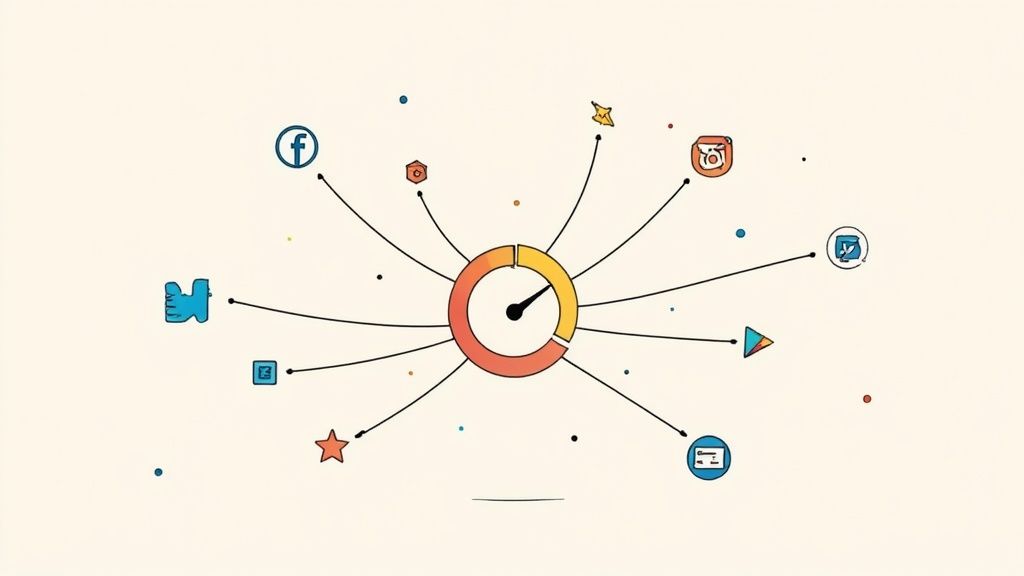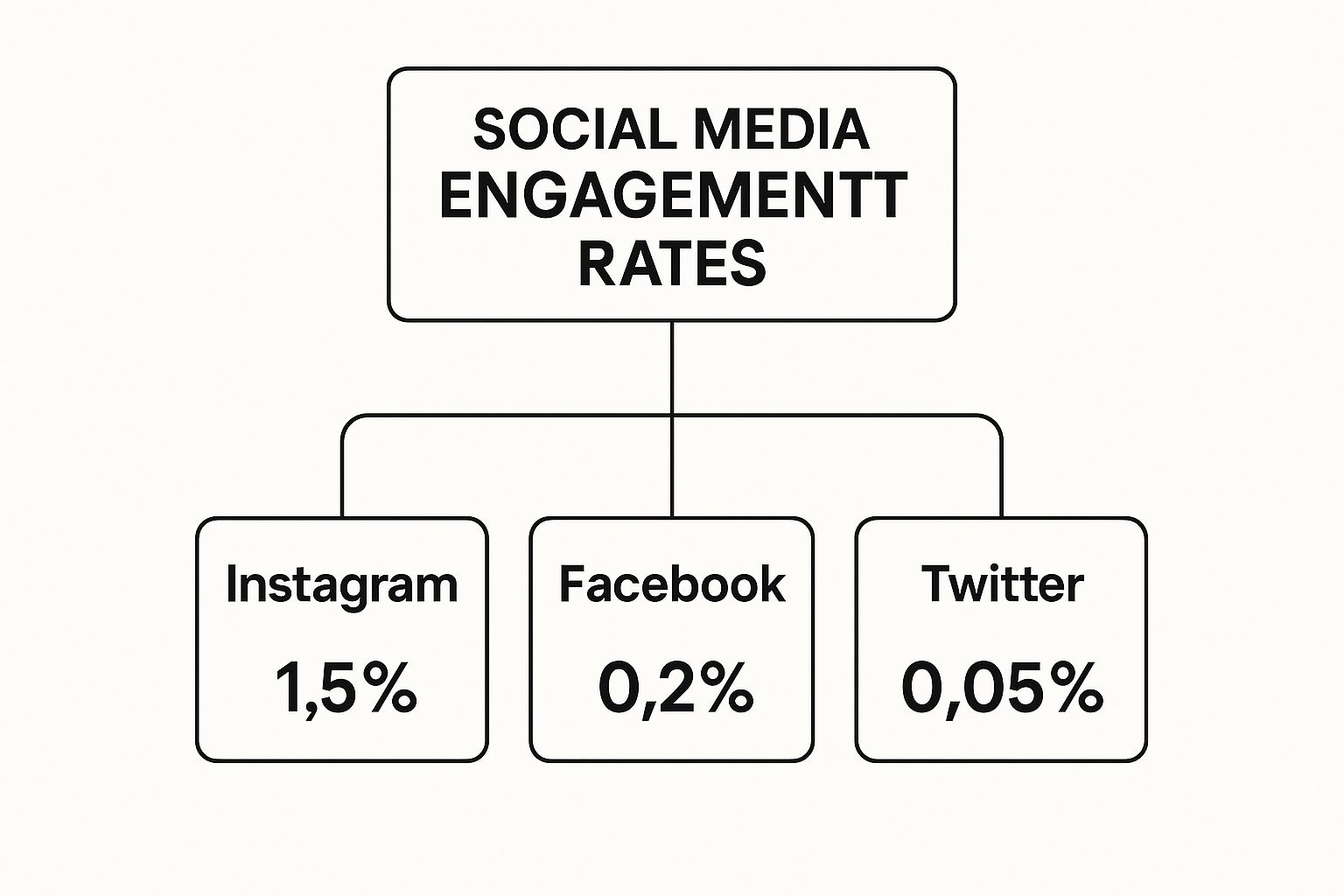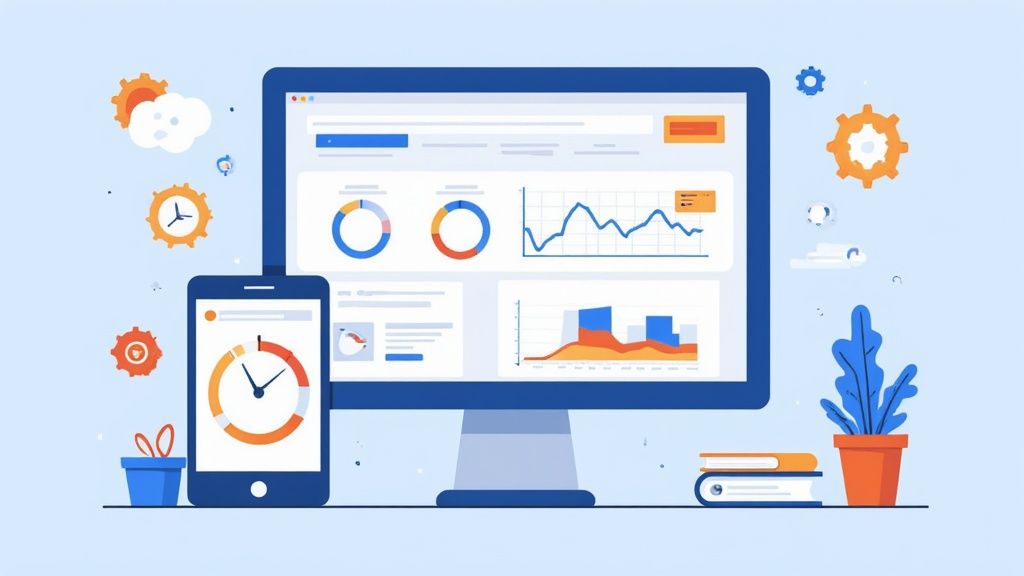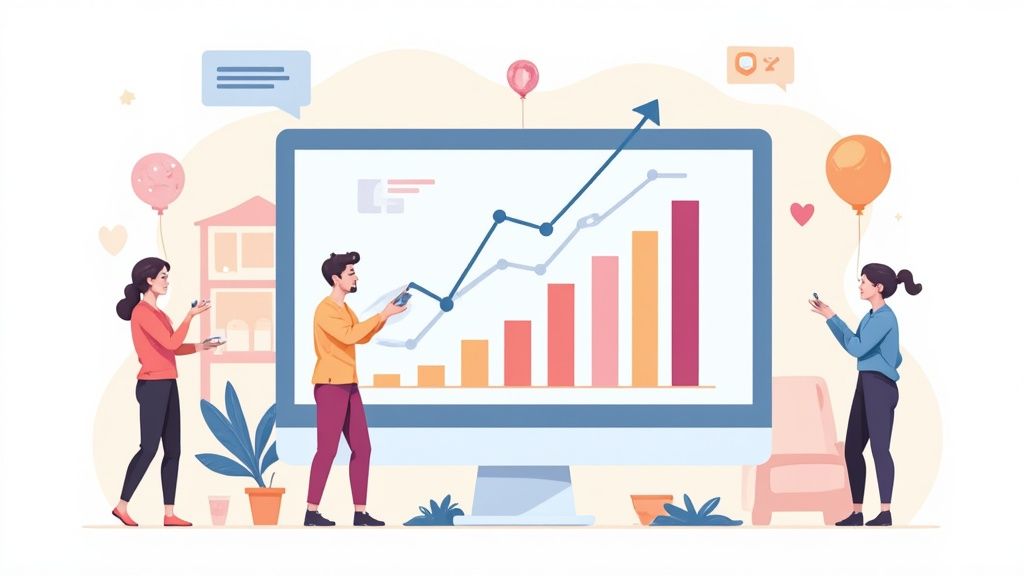Why Social Media Engagement Rates Really Matter
So you’ve got a ton of followers and your posts are getting thousands of impressions. That’s great, but it's only half the story. Chasing these "vanity metrics" is a common trap for online sellers. While those numbers look impressive on paper, they don't always translate into a healthy business.
Think of your social media page like a physical storefront. Impressions are all the people walking by your window. Engagement? That’s the person who stops, comes inside, asks about your products, and starts a conversation. Which one is more likely to become a customer?

High social media engagement rates are the true pulse of your brand. They prove that people aren't just scrolling past your content—they're actually connecting with it. This interaction is one of the strongest signals you have that you're on the right track.
The True Value of an Engaged Audience
Engagement is what turns a crowd of passive followers into an active, thriving community. Every time someone comments, shares, or saves one of your posts, they're building a genuine relationship with your brand. This two-way street is infinitely more valuable than just shouting your message into the void.
This connection creates a powerful foundation for your business:
- Real Brand Loyalty: When followers feel like you're listening, they're far more likely to stick around and choose you over a competitor.
- Authentic Social Proof: A comment section full of happy customers is more convincing than any ad you could ever run. It’s a real-time testimonial that builds instant trust.
- Better Visibility: Social media algorithms are designed to push content that people find interesting. High engagement tells the platform, "Hey, people love this!" and it gets shown to more users.
An engaged audience is your most valuable asset. Each comment is a piece of feedback, each share is a word-of-mouth referral, and each like is a vote of confidence in your brand's message.
How Engagement Drives Your Business Forward
At the end of the day, all these likes and comments need to lead somewhere. The good news is, they do. With a staggering 5.45 billion people expected to be on social media by 2025, these platforms have become a critical stop on the path to purchase.
Consider this: 25.9% of users are actively searching for products on social media, and another 26.6% are there just to find inspiration for things to buy. Your engaging content puts your products right in front of them at the perfect moment.
A healthy engagement rate is proof that you're not just posting, you're building a community that trusts you and is ready to buy. To dig deeper into building this kind of community, it's worth understanding what goes into an effective social media engagement strategy. It’s the essential bridge between having a social media presence and actually making sales.
Calculating Your Social Media Engagement Rate
Talking about social media engagement rates without knowing how to calculate them is like trying to bake a cake without a recipe. You know you want a delicious result, but you have no real way to measure your ingredients or track your progress.
The good news? The math here is surprisingly simple. What's more important, though, is the story the numbers tell. Calculating your engagement isn't about chasing one single, all-powerful metric. It’s about picking the right formula to answer the right question about your content's performance.
This infographic breaks down the average engagement rates across the big platforms. It gives you a solid baseline for what's considered "normal" out in the wild.

As you can see, what counts as a “good” rate on a platform like Instagram, with its 1.5% average, is worlds apart from what you’d see on Facebook or Twitter. This is a perfect example of why context is everything when you’re looking at your own numbers.
A Practical Guide to Engagement Rate Formulas
To really get a handle on your performance, you'll want to get comfortable with a few key formulas. Think of them as different lenses you can use to examine your content's impact. Each one offers a unique perspective.
Here’s a quick rundown of the main formulas you’ll encounter and, more importantly, when to pull each one out of your toolkit.
| Formula Name | How to Calculate It | When to Use This Formula |
|---|---|---|
| Engagement Rate by Reach (ERR) | (Total Engagements / Total Reach per Post) x 100 | This is your go-to for measuring content quality. It tells you how compelling your post was to the people who actually saw it. |
| Engagement Rate by Post (ERP) | (Total Engagements on a Post / Total Followers) x 100 | Use this to compare different posts against each other. It helps you spot trends and see what resonates most with your follower base. |
| Engagement Rate by Impressions | (Total Engagements / Total Impressions) x 100 | Perfect for paid campaigns. It shows how often people chose to interact after seeing your ad, even if they saw it multiple times. |
| Daily Engagement Rate | (Total Engagements in a Day / Total Followers) x 100 | Great for understanding how consistently your audience interacts with your brand daily, regardless of how many posts you share. |
Each of these formulas helps you answer a different question. Are you trying to figure out if your content itself is hitting the mark? ERR is your best bet. Want to see which of your last five posts performed best? ERP will give you a clear winner.
By using a mix of these calculations, you start to build a much richer, more complete picture of your social media health. For instance, a post might have a low ERP but a sky-high ERR. That’s a huge clue! It tells you the content itself is fantastic, but you have an opportunity to improve its reach.
If you want to get even deeper into the practical side of this, it's worth learning how to measure social media engagement effectively. Mastering these simple formulas is the first step to moving beyond guesswork and making smart, data-backed decisions that actually grow your online store.
Understanding Engagement Benchmarks Across Platforms
So you've calculated your engagement rate. You have a number. Now what?
That number, on its own, is pretty useless. It's like a chef telling you to bake something at "200" without specifying Celsius or Fahrenheit. A 2% engagement rate could be fantastic on one social media platform and a total flop on another. This is exactly why getting a grip on platform-specific benchmarks is a non-negotiable part of setting goals you can actually hit.
Every social network is its own little world, with its own algorithm, its own culture, and its own user habits. Think about it. A visual playground like Instagram is built for rapid-fire interactions—double-taps, quick story replies, and effortless shares. Higher engagement is just baked into the experience.
But then you have a place like LinkedIn, which is more like a professional networking event. Interactions there are more considered and less frequent. A "good" rate on LinkedIn is going to look completely different from a good rate on Instagram.

Trying to chase the same engagement number across all your channels is a recipe for frustration. It's like expecting a sprinter and a marathon runner to post the same lap times. You have to adjust your expectations—and your content—to fit the unique vibe of each platform.
Setting Realistic Performance Goals
To set goals that aren't just wishful thinking, you need to know what's typical for each network. A brand seeing a 1.8% engagement rate on Instagram might feel a little deflated, but then they learn the industry average is hovering around 2%. All of a sudden, that 1.8% looks pretty solid.
For online sellers, this context is pure gold. It helps you pour your creative energy where it’ll actually make a difference. If you sell visually stunning products, for example, it makes perfect sense to double down on Instagram with jaw-dropping images. Getting your visuals right is key, and you can find great tips on using a Shopify photo editor to really make your products pop off the screen.
Understanding these benchmarks also helps you troubleshoot problems without pulling your hair out. Is your Facebook engagement in the gutter because your content is failing, or is it just tracking with the platform's naturally lower interaction rates? That distinction is everything. It helps you make smart decisions instead of chasing impossible numbers and burning out.
Navigating a Shifting Social Landscape
Here's another thing: these benchmarks aren't set in stone. The social media world changes constantly. What was considered a rockstar engagement rate last year might be just average today.
A recent deep dive into social media engagement rates for 2025 uncovered a major downward trend across the board. Facebook's engagement dropped by 36%, Instagram's slid by 16%, and X (formerly Twitter) took a massive 48% hit.
This trend points to a social space that's getting more crowded and competitive. The algorithms are getting smarter, favoring genuine interaction, and users are getting way more picky about what they engage with.
This data isn't a sign that social media is dying; it just means the bar for quality has been raised. As an online seller, your strategy has to evolve. It's less about shouting into the void and more about starting real conversations with genuinely valuable content. You can check out more insights on these 2025 benchmarks to get a clearer picture and sharpen your strategy.
Five Proven Strategies to Boost Engagement
Getting a handle on your social media engagement rates is a great first step, but the real magic begins when you put that knowledge to work. It’s time to go beyond the numbers and start using strategies that spark real, measurable interaction.
Forget the generic advice. These five tried-and-true tactics are built specifically for online sellers who need to see results. Each one is a practical move you can make today to build a more active and loyal community around what you sell.
Start Conversations, Not Broadcasts
The fastest way to send your engagement plummeting is to only talk at your audience. Social media is a two-way street, not a billboard. Your goal is to create content that feels less like an ad and more like the start of a genuine conversation.
This is where simple interactive features become your best friend. Think polls, quizzes, and open-ended questions that are fun and effortless for your followers to answer. Ask them to vote on a new product color, share how they use your item, or guess what you're launching next. This small change in approach can turn passive scrollers into active participants.
The most successful brands on social media don't just sell; they facilitate conversations. When you invite your audience to share their opinions, you make them feel heard and valued—and that’s the real foundation of a strong community.
Not only does this approach pump up your visible metrics, but it also hands you priceless customer feedback. Every poll response and comment is a direct line into your customers' minds, giving you real data to fine-tune your products and marketing.
Master the Art of the Scroll Stop
In a feed that never ends, your visuals are your first, and often only, chance to grab someone's attention. Generic stock photos and blurry phone pictures just don't cut it anymore. Your images have to be sharp, compelling, and professional enough to literally make someone stop scrolling.
For online sellers, this is completely non-negotiable. Your product photos have to do the heavy lifting of showcasing quality, detail, and value. Honestly, investing in high-quality visuals is one of the most direct ways to improve your social media engagement rates. When a product looks incredible, people are far more likely to like, comment, and tag their friends.
Beyond your own professional shots, you should actively encourage and feature user-generated content (UGC). When a customer tags you in a photo showing off their new purchase, share it! UGC acts as powerful social proof that feels authentic and trustworthy, building community and encouraging others to share their own pictures.
Find Your People in Niche Communities
Instead of shouting into the void trying to appeal to everyone, focus your energy on reaching the right people. Your most engaged audience is often hanging out in smaller, niche communities built around specific interests. Finding and getting involved in these spaces can be a total game-changer.
This means going deeper than just slapping a few popular hashtags on a post. Research and use a mix of broad and super-specific hashtags that your ideal customers are actually following. For instance, a handmade jewelry seller might use #HandmadeJewelry, but they'll get more traction with niche tags like #BohoChicEarrings or #MinimalistGoldNecklace.
Join relevant Facebook Groups or Subreddits where your target audience geeks out about their passions. But don't just jump in and start spamming your links. Participate genuinely, offer helpful advice, and build real relationships. This makes you a trusted member of the community, not just another outsider trying to make a sale. For sellers using platforms like Facebook Marketplace, having visuals that stand out is critical, and our guide to Facebook Marketplace selling photo editing can give you that edge.
Perfect Your Post Timing with Analytics
You could create the most brilliant post in the world, but if you publish it while your audience is asleep, it's going to fall on deaf ears. Posting at the right time is a simple but incredibly powerful way to maximize your visibility and that all-important initial wave of engagement.
It's time to dive into your platform’s built-in analytics—like Instagram Insights or Facebook Page Insights. These tools will show you exactly when your followers are most active online, broken down by both the day of the week and the hour of the day.
Use this data to build a posting schedule that lines up with these peak activity times. Don't be afraid to test different times around these windows to see what works best. A post that gets a strong burst of likes and comments right after it goes live is far more likely to be pushed by the algorithm to an even wider audience.
Turn Comments into Meaningful Connections
The final piece of the puzzle is what happens after someone engages. Every single comment is an opportunity to strengthen a relationship. A quick "thanks!" is nice, but a thoughtful, personalized response is so much better.
When someone leaves a comment, take a second to click on their profile. Reply using their name and maybe ask a follow-up question to keep the conversation rolling. This simple act shows you're paying attention and that you genuinely care about what they have to say. Not only does this encourage that person to engage with you again, but it also signals to everyone else that you're an active, responsive brand worth following.
How Global and Regional Trends Impact Your Strategy
Your social media strategy can't live in a bubble. What absolutely crushes it in one country might fall completely flat in another. For any online seller trying to connect with a worldwide audience, understanding how social media engagement rates change from place to place is non-negotiable.
Let's be blunt: a one-size-fits-all approach is just a recipe for wasted time and money.
Think of it like this: you wouldn't use the same sales pitch at a chaotic street market in Marrakesh as you would in a quiet, high-end boutique in Tokyo. The culture, the pace, the way people interact—it’s all different. Social media is exactly the same. User habits, which apps they love, and even when they’re scrolling can change drastically from one corner of the globe to the next.

This is precisely why you have to localize your content. And it’s about so much more than just translating captions. It's about rethinking your entire vibe to match the cultural pulse of the people you want to reach.
Why Global Averages Can Be Misleading
Looking at global data is a decent starting point, but it often papers over the fascinating local details that can make or break your entire strategy. The differences between regions are huge, and they directly affect how, when, and where you should be posting your content.
For instance, 2025 data shows the average person spends about 141 minutes a day on social media. But that "average" is hiding some wild variations. In the Philippines, people are online for a staggering 3 hours and 38 minutes daily. Compare that to the United States, where it's closer to 2 hours and 9 minutes. This proves that a high-frequency posting schedule that works wonders in one market could completely annoy and overwhelm users in another. You can dive deeper into how these global social media statistics influence marketing to see the full picture.
Your strategy has to be nimble enough to respect these local differences. Assuming a global average applies to your specific market is one of the fastest ways to watch your engagement rates flatline.
Adapting Your Strategy for Different Markets
To really win on a global scale, you've got to get your hands dirty and dig into the data for your specific target regions. Start by asking yourself a few critical questions:
- Which platforms are king? Sure, Facebook and Instagram are giants, but in some countries, a local platform might be where everyone really hangs out.
- When are people actually online? Don't just post on your own time. You have to think about time zones and the daily rhythm of life in that specific location.
- What kind of content actually connects? Cultural values and local trends will decide whether a funny meme, an emotional story, or a straightforward educational post is going to land best.
By tailoring your content and timing to these local behaviors, you’re sending a clear message to your audience: "We get you." This localized approach is the secret to building real connections and driving the kind of engagement that actually matters, no matter where your customers live.
Common Questions About Social Media Engagement
Even after you've got a handle on the formulas and strategies, a few questions about social media engagement rates tend to pop up again and again. Let's tackle some of the most common head-scratchers to clear up any lingering confusion.
What Is Considered a Good Engagement Rate?
There's no magic number here. Anyone telling you there's a single "good" rate is simplifying things way too much. What counts as "good" is completely tied to your industry, the specific platform, and how big your audience is.
As a general rule of thumb, a rate between 1% and 5% is usually considered pretty healthy for most brands. But a small business with a super-passionate, tight-knit community might easily hit rates over 10%, which is fantastic. The best way forward is to stop chasing some universal number and start benchmarking against your own history and your direct competitors. Your real goal should always be steady, consistent improvement.
Why Is My Reach High but My Engagement Low?
This is easily one of the most frustrating things for online sellers. You see a post reach thousands of people, but only a handful of likes trickle in. It’s a classic sign of a disconnect between what you're posting and what your audience actually cares about.
High reach means the platform's algorithm is doing its job and showing your post to people. Low engagement means it just wasn't compelling enough to make them stop scrolling and interact. A few things are likely to blame:
- Weak Visuals: Your product photos might not be sharp, clear, or interesting enough to grab attention in a crowded feed.
- Missing a Hook: Your caption is flat. It doesn't ask a question, spark curiosity, or give people a clear reason to respond.
- Content Mismatch: You posted something that just doesn't align with what your followers expect or want to see from you.
Think of high reach with low engagement as direct feedback. Your audience is basically saying, "We see you, but we're not interested." It's your cue to take a hard look at your content strategy and double down on what has worked before.
How Often Should I Post to Increase Engagement?
Posting more doesn't automatically lead to more engagement. In fact, spamming your followers with a bunch of low-effort content is a fast way to lose them for good. The perfect posting schedule is all about quality and consistency, not just quantity.
One incredible, visually stunning post a day will always beat three rushed, mediocre ones. Dive into your analytics to see when your audience is most active, and then schedule your best stuff for those peak hours. For sellers, creating a steady stream of beautiful images can be a real grind. This is where an AI product photo generator can be a total game-changer, helping you churn out studio-quality visuals without the massive time suck. Test different posting frequencies and let your data show you what works.
Ready to transform your simple product photos into scroll-stopping visuals that drive engagement? With ProdShot, you can create professional, high-converting images in seconds. Start your free trial today and see the difference for yourself!

